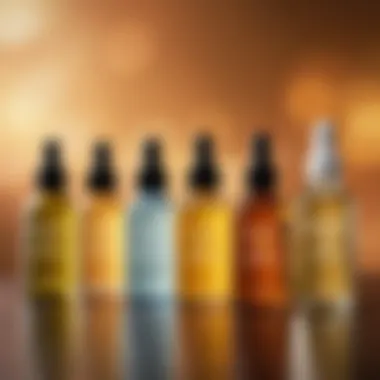Exploring the Advantages of Hydrophilic Oil for Skin


Intro
In recent years, hydrophilic oils have gained traction in skincare routines, proving to be game-changers for both men and women across all age groups. These oils are unique because they blend easily with water, allowing them to serve as effective cleansers while providing hydration—the best of both worlds. This dual functionality means that hydrophilic oils can do much more than just remove makeup; they can also nourish and rectify your skin's unique issues.
As we delve deeper into this article, we'll explore the numerous advantages of hydrophilic oils for facial skin. We will not only touch on how they cleanse and moisturize but also examine their specific benefits across different skin types. Additionally, we will discuss how to choose the right hydrophilic oil for your particular needs. The aim is to equip you with the knowledge necessary to enhance your skincare routine successfully.
Популярные акции и предложения
When searching for hydrophilic oils, it’s wise to pay attention to current promotions. Many well-known beauty brands often run seasonal sales or limited-time discounts. This can be a fantastic opportunity to try new products without breaking the bank.
Here’s what to keep in mind:
- Overview of Current Discounts on Cosmetic Brands
Many brands are offering compelling discounts right now. Brands like Burt's Bees and The Ordinary are renowned for their hydrophilic oils and often have promotions that can make these products more accessible. Keep an eye on their websites and social media pages for the latest offers. - Seasonal Sales and Special Offers
Most skincare brands have specific times of the year when they run sales, such as the holidays or summer clearance. This can be a great time to invest in hydrophilic oils, allowing you to stock up without feeling guilty about your spending.
Рекомендации по выбору косметики
Choosing the right hydrophilic oil can feel a bit daunting due to the variety available. But worry not; it's all about finding what works best for your skin type and any skin issues you might have.
- How to Choose Cosmetics Based on Skin Type
- Tips for Selecting Cosmetics for Different Age Groups
- If you have oily or combination skin, you might consider oils that include jojoba or grapeseed, as they emulate the skin’s natural oils and help to control shine.
- For dry or sensitive skin, oils like argan or avocado can provide much-needed moisture while also being gentle on the skin.
- Younger skin (teens to twenties) often benefits from lighter textures, so lighter hydrophilic oils can prevent clogging pores.
- Mature skin usually requires richer oils that deeply nourish and hydrate, offering an extra layer of protection against environmental stresses.
"Finding the right hydrophilic oil is not just a routine; it's an investment in your skin’s long-term health.
While doing research, remember to read user reviews and ingredients to find what suits you best. Each skin type is unique, and the benefits can vary significantly depending on the oil you choose.
As we unravel the complexities of hydrophilic oils, each aspect of their use will become clearer. By the end of this article, you should feel empowered to integrate these oils into your skincare journey, enhancing your routines and ultimately your skin's health.
Understanding Hydrophilic Oil
When you dive into the world of skincare, it's hard to overlook the impact of hydrophilic oils. These remarkable products sit at the intersection of cleansing and moisturizing, which makes them a noteworthy addition to any skincare arsenal. Not just a trend or a buzzword, hydrophilic oils deliver real benefits that can transform your skin. Understanding their essence is the first step towards leveraging their full potential.
Definition and Composition
Hydrophilic oil refers to oil-based formulations designed to mix with water and interact favorably with the skin. These oils, unlike traditional oils, possess unique compositions that allow them to attract water. Commonly, they contain a blend of various natural oils such as sunflower and canola oil, often enhanced with emulsifiers or surfactants. Because of this formulation, they can dissolve makeup, dirt, and other impurities from the skin, making them effective and efficient.
What’s more, the inclusion of nourishing ingredients often enriches these oils, adding beneficial properties that promote skin health. Take, for instance, a hydrophilic oil infused with vitamin E; these added benefits contribute to antioxidants, which help combat free radicals.
How It Differs from Traditional Oils
The distinction between hydrophilic oils and traditional oils lies primarily in their interaction with water. Traditional oils, like olive or coconut oil, do not emulsify with water, meaning they can sometimes leave a greasy residue on the skin. This can be an issue for individuals looking for effective cleansing methods without the leftover slickness. In contrast, hydrophilic oils easily mix with water, allowing for a rinse-off that traditional oils simply cannot achieve.
Moreover, the cleansing action of hydrophilic oils assists in removing even waterproof makeup, demonstrating their efficiency. They essentially function as a bridge between oil and water, maximizing both cleansing and hydrating benefits simultaneously. For instance, if you've ever tried to dissolve stubborn mascara with a traditional oil, you might find it a hassle, whereas a hydrophilic oil takes care of that quite effortlessly.
Key Takeaway: The unique property of hydrophilic oils allows them to cleanse effectively without leaving skin feeling stripped or oily, catering to those who seek balance in their skincare routine.
In summary, understanding the nuances of hydrophilic oil is invaluable for anyone keen on optimizing their skincare routine. The unique composition and application make them distinct from traditional oils, and this knowledge arms you with insights that can enhance your skin health significantly.
The Science of Emulsification
The emulsification process is central to understanding how hydrophilic oils work effectively on facial skin. Simply put, emulsification is the blending of water and oil, creating a mixture that can provide both cleansing and hydrating benefits. Without this process, using oils on the face could feel heavy and greasy rather than refreshing and light. The science behind emulsification allows for the unique properties of hydrophilic oils to shine through, giving us products that perform exceptionally well for various skin types.
Understanding Oil and Water Interaction
Oil and water, it seems, are like oil and water, often thought to never mix well. However, this assumption does not hold when it comes to hydrophilic oils. These oils are engineered to interact seamlessly with both elements, which is primarily because of their unique composition. When you apply a hydrophilic oil to your skin, it attaches to both water and oil molecules, allowing for effective cleansing. It binds with dirt and impurities that are oil-based, while also being able to wash away with water easily.
The magic happens due to the creation of an emulsion, which is a stable mixture of oil and water. When rinsing with water, the oil phase encapsulates the dirt and impurities, enabling them to be washed away easily. This ability to dissolve makeup and grime while also leaving skin feeling soft is crucial. It strikes a fine balance between cleansing and maintaining moisture, which is often a challenge with typical soaps or cleansers. In essence, the interaction of oil and water via emulsification is what makes hydrophilic oils stand out in facial cleansing.


Role of Surfactants
Surfactants play a pivotal role in the emulsification process. They are compounds that lower the surface tension between two liquids or between a liquid and a solid, essentially allowing them to mix more easily. In the context of hydrophilic oils, surfactants help to stabilize the mixture of oil and water, ensuring that they do not separate.
These surfactants are key ingredients in hydrophilic oils, as they enable those oils to cleanse effectively without stripping the skin of its natural barrier and moisture. By binding with oils and impurities, surfactants allow your product to be rinsed away with water, thus removing unwanted buildup while keeping the skin hydrated.
Furthermore, not all surfactants are created equal. Some may be harsh, causing irritation for sensitive skin types. Therefore, it is vital to select hydrophilic oils that contain gentle surfactants, such as glyceryl stearate or polysorbates, which can provide the benefits of emulsification without detrimental side effects.
In summary, understanding the science of emulsification is critical for appreciating the advantages hydrophilic oils bring to facial skincare. The interaction of oil and water, facilitated by surfactants, enables these products to effectively cleanse while providing necessary hydration, making them a remarkable addition to any skincare regimen.
Benefits for Facial Skin
The incorporation of hydrophilic oil into facial skincare routines has gained traction due to its multifaceted advantages. These oils bridge the gap between cleansing and moisturizing, tapping into the natural balance of facial skin. For many, understanding the specific benefits can dictate the efficacy of their skincare regimen.
The role of hydrophilic oil is critical, especially when considering how it interacts with various skin types and concerns. From foundational cleansing abilities to moisturizing prowess, these oils offer a dynamic approach to skincare.
Effective Cleansing Properties
One of the standout features of hydrophilic oil is its ability to cleanse effectively without stripping the skin of its natural barriers. The blend of oils and surfactants in these formulations allows for removal of impurities, makeup, and excess sebum with great ease.
Unlike traditional oils, which might leave a greasy residue, hydrophilic oils emulsify with water, transforming into a milky texture that rinses away clean. This is particularly helpful for individuals who wear makeup or live in urban areas where pollution is high.
The cleansing process is gentle, ensuring the skin retains its fundamental moisture. Many users find this dual cleansing and moisturizing ability to be a game changer.
Hydration and Moisture Retention
Hydrophilic oils are renowned for their impressive hydration capabilities. They are formulated to attract and bind moisture, giving the skin a plump, dewy appearance. This unique characteristic plays a crucial part in maintaining the skin's moisture balance.
When applied, these oils create a barrier that helps prevent moisture loss throughout the day, especially in climates that are either too dry or excessively humid. For those battling flaky skin, introducing hydrophilic oil can mean the difference between a parched visage and a hydrated glow.
Incorporating hydrophilic oil into a daily routine not only nourishes but also enhances the skin's natural resilience against environmental stressors.
Balancing Oily and Dry Skin
Another significant benefit of using hydrophilic oil is its effectiveness in balancing skin types – whether oily, dry, or combination. For those with oily or acne-prone skin, the idea of using oil can seem counterproductive. However, hydrophilic oils help to regulate sebum production while keeping the skin properly hydrated. This keeps it from overcompensating and creating more oil than necessary.
On the flip side, individuals with dry skin can find relief from tightness through consistent use. This balance is achieved through the ability of hydrophilic oil to accommodate various skin needs without compromising its natural function.
Thus, it serves as a versatile agent in achieving that sought-after equilibrium in skincare, making it suitable for a broad audience.
"The right hydrophilic oil can be like finding gold in your skincare routine, working tirelessly for both oily and dry skin types."
In summary, the myriad benefits of hydrophilic oils underscore their importance in today's skincare landscape. They effectively cleanse, hydrate, and balance the skin, proving to be essential tools for anyone looking to enhance their skincare practices.
Suitability for Different Skin Types
Understanding how hydrophilic oil interacts with various skin types is crucial for choosing the right product. Not all oils are created equal, and hydrophilic oils provide unique benefits depending on whether your skin is oily, dry, or a mixture of the two. This section will explore the suitability of hydrophilic oils for these skin types and highlight key considerations to help users select the best option for their skincare routines.
Oily and Acne-Prone Skin
For those with oily and acne-prone skin, one might think incorporating any oil into a skincare regimen is counterproductive. However, hydrophilic oils can be a game-changer. These oils do not clog pores; instead, they assist in effectively removing impurities and excess oil. When used in cleansing, hydrophilic formulations effectively emulsify with sebum and makeup, making it easier to wash away dirt without harsh scrubbing.
Additionally, many hydrophilic oils contain ingredients like chamomile or tea tree oil, which can help calm inflammation and fight breakouts. They also help in maintaining the skin's barrier, so it doesn’t compensate for lost moisture by producing even more oil.
"Using oil on oily skin? Sounds odd, but it’s the magic of hydrophilic oils that can balance your skin out."
Dry and Sensitive Skin
Dry and sensitive skin often face challenges like irritation and redness, making hydrophilic oils ideal for this group. These oils provide ample hydration, as they not only cleanse the skin but also retain moisture. Ingredients like grape seed oil or sunflower oil in these formulations help to nurture and soothe the skin. They create a protective layer that minimizes transepidermal water loss, keeping the skin hydrated and supple.
Moreover, the gentle nature of hydrophilic oil is especially beneficial for those prone to eczema or rosacea. The non-comedogenic properties mean they won’t exacerbate dryness or breakouts, allowing users to cleanse comfortably without the risk of irritation.
Combination Skin
Combination skin presents a unique puzzle, with areas that are oily while others might be dry. Hydrophilic oils cater to this complexity effectively. They provide a balanced approach, cleansing the oily zones without stripping moisture from the dry patches. When applied, the oil can adapt, catering to the needs of specific areas of the face.
For instance, if you’re using a product with light oils like jojoba or grapeseed, these may lessen the likelihood of shine in the T-zone while delivering nourishment to drier regions. Combination skin types can benefit from the versatility of hydrophilic oils, which allow for a tailored approach to skincare depending on daily needs.
Application Techniques
Understanding how to effectively use hydrophilic oil is crucial for maximizing its benefits for facial skin. Unlike traditional oils, which may not interact as seamlessly with water, hydrophilic oils are designed to cleanse while also providing hydration. Therefore, mastering application techniques can transform a skincare routine from ordinary to extraordinary.
How to Use Hydrophilic Oil


Using hydrophilic oil starts with a few simple steps. First, take a small amount of product—about the size of a coin—and apply it to dry skin. Gently rub the oil over the entire face, moving in circular motions to ensure even coverage. This encourages a thorough breakup of makeup, dirt, and impurities.
After a minute or so of massaging, wet your hands and then continue massaging the oil into your skin. Adding water helps to emulsify the product, turning it into a milky texture. This transition is essential because it allows the oil and water to mix, enhancing the cleansing process. Finally, rinse your face with lukewarm water. It’s like a mini spa treatment, granting your skin a refreshing cleanse without stripping it of its natural oils.
Incorporating into a Skincare Routine
The beauty of hydrophilic oils is not limited to standalone use. They can be seamlessly integrated into a broader skincare routine. For optimal results, consider the following:
- Double Cleansing: Use hydrophilic oil first to dissolve makeup, followed by a gentle water-based cleanser to wash away the residue. This helps achieve a deep clean.
- Prepping the Skin: After cleansing, apply hydrophilic oil to slightly damp skin. This aids in trapping moisture, enhancing hydration from the get-go.
- Layering Products: Post-cleansing, follow up with serums and moisturizers. Hydrophilic oils can act as a base, ensuring that subsequent products are absorbed effectively.
Pairing with Other Products
Pairing hydrophilic oil with complementary skincare products can amplify its benefits. Here’s how to do it:
- Moisturizers: Choose lightweight moisturizers that avoid heavy occlusives after applying hydrophilic oil. This balance helps in retaining moisture without overwhelming the skin.
- Exfoliants: Integrate gentle exfoliants a few times a week. Just make sure to wait some time after using hydrophilic oil, to not irritate the skin.
- Sunscreen: Always finish with sunscreen during the day. Hydrophilic oils can provide a barrier, but nothing replaces the need for UV protection.
"Incorporating hydrophilic oil into your daily routine can enhance hydration and aid in effective cleansing, paving a path for healthier skin."
By focusing on these specific techniques—how to use, incorporate into routines, and effectively pair with other products—a clearer view emerges on how hydrophilic oils can be truly transformative. Every step matters, turning a simple regime into a nourishing ritual.
Common Misconceptions
When it comes to skincare, especially products like hydrophilic oil, there are often misunderstandings that can lead to misguided choices. Misconceptions about how these oils work can prevent many individuals from opting for a solution that could greatly benefit their skin. To effectively incorporate hydrophilic oil into your routine, it's essential to clear the fog around these myths so that you can make informed decisions for healthier skin.
Myths About Oil Cleansing
One of the most prevalent myths floating around is the belief that oil cleansing is only suitable for those with dry skin. This misconception might stem from the basic notion that oil can lead to more oil, especially among people with oily or acne-prone skin. However, this could not be farther from the truth. Hydrophilic oils can indeed draw out sebum and impurities effectively, making them a great option for all skin types, including those that are oily.
Another common myth regarding oil cleansing is that it will leave the skin feeling greasy or clogged. Many folks worry that using an oil-based product will make their skin worse. On the contrary, hydrophilic oil is crafted to emulsify, meaning it bonds with water. When rinsed off, it takes away the impurities without leaving a heavy residue behind. In fact, many users experience improved skin clarity and texture after using hydrophilic oils regularly.
While some might think that oil cleansing is complicated, the truth is it can be surprisingly straightforward. You don’t need to be an expert to benefit from its properties. A simple application step followed by water will suffice, making it an accessible practice for anyone.
Reality of Hydrophilic Oil Use
Understanding the realities of hydrophilic oil’s use is vital. These oils not only cleanse well but also help maintain the skin’s moisture balance. Users often report that their skin feels nourished rather than stripped, which can be a game changer for those who tend to use harsh soaps and cleansers.
Here's what you should know about hydrophilic oils:
- Not Just for Dry Skin: It’s versatile, fitting into any skin type. Whether your skin is oily, dry, or somewhere in between, hydrophilic oil can provide immense benefits.
- Gentle Yet Effective: It removes even the most stubborn makeup without aggravating the skin, making it a favourite choice for sensitive skin types.
- Easy to Incorporate: Using hydrophilic oil isn’t a hassle. With a few pumps and a splash of water, you can easily elevate your skincare game.
"Oil cleansing isn’t just a cleansing method; it’s a step towards a more balanced, healthy complexion."
Moreover, many high-quality hydrophilic oils are formulated with additional beneficial ingredients like essential fatty acids and vitamins that further enhance skin health. By keeping an eye out for certain key ingredients, you can choose oils that not only cleanse but also nourish and rejuvenate the skin.
In closing, recognizing and dismantling these misconceptions about hydrophilic oils is the first step toward reaping their full benefits. With clearer insight into how these oils function and who they’re for, it’s easier to adopt new and beneficial habits in personal skincare routines.
Choosing the Right Hydrophilic Oil
Selecting the correct hydrophilic oil for your skincare routine is key to maximizing its effectiveness. Whether you have sensitive skin or an oily complexion, the right choice can make all the difference. A good hydrophilic oil can alleviate skin issues, enhance hydration, and improve overall appearance. However, with countless options available on the market, understanding what makes a hydrophilic oil suitable for your specific skin type and concerns is essential.
Key Ingredients to Look For
Not all hydrophilic oils are created equal. Here’s a closer look at some important ingredients to consider when making your selection.
- Natural Oils: Look for hydrophilic oils that contain natural ingredients such as jojoba oil, grape seed oil, or sunflower oil. Natural oils are generally lighter and less likely to cause breakouts.
- Emollients: Ingredients like shea butter or vitamin E can provide added hydration, helping to lock in moisture while cleansing your skin.
- Surfactants: Hydrophilic oils often include mild surfactants that help dissolve impurities and makeup without stripping your skin of its natural oils.
- Antioxidants: Ingredients such as green tea extract or rosehip oil provide additional protection against environmental damage, brightening the skin over time.
When reading labels, ensure that these ingredients are near the top of the list. This is generally a good indication that they are present in effective amounts.


Identifying Quality Brands
Choosing a reputable brand is equally as critical as the ingredients themselves. Here are a few tips for identifying quality hydrophilic oils:
- Reputation: Research brands with positive reviews and recommendations from skincare professionals. Brands with transparent practices and ingredient sourcing often stand out.
- Certifications: Check for certifications that speak to the authenticity and quality of the product, such as organic or cruelty-free designations.
- Third-Party Testing: Some brands invest in third-party testing to ensure their products are effective and safe. Such transparency can be a positive indicator of quality.
- Focus on Specific Needs: If you have sensitive skin, you might want to choose brands that specialize in formulations tailored for delicate skin types. Look for those that offer a limited ingredient list and use gentle components.
Understanding these factors can help consumers make informed decisions, ensuring they choose the most effective hydrophilic oils for their skincare regimen.
"The right hydrophilic oil not only cleanses but also nourishes, promoting a healthier and more radiant complexion."
Potential Side Effects and Considerations
When integrating a new skincare product into your routine, awareness of potential side effects can make all the difference. Hydrophilic oil, although a multifaceted ally in skincare, is no exception. Understanding the possible reactions it might incite on varied skin types ensures that you can make informed choices, safeguarding your skin’s health while still enjoying its benefits.
Possible Reactions
While hydrophilic oils are generally designed to be gentle and effective, individual responses can vary. Here are several reactions that some users might encounter:
- Breakouts: For individuals with oily or acne-prone skin, introducing hydrophilic oil can sometimes lead to unexpected breakouts. This usually happens when the skin's oil production is disrupted during the adjustment period.
- Irritation and redness: Some ingredients in hydrophilic oils may not mesh well with sensitive skin. If you notice any redness or discomfort, it could be a sign that your skin is reacting negatively.
- Allergic responses: Though rare, allergic reactions can occur. It’s essential to read ingredient lists carefully. If you know you’re allergic to specific substances, steer clear of oils containing them.
"Taking care of your skin is a lifelong commitment, not a quick fix; a little caution can save you a lot of trouble."
Patch Testing and Sensitivities
To minimize the risk of adverse reactions, patch testing is an invaluable step. This simple practice can help you identify any sensitivities your skin might have:
- Select a small area: Choose a discreet area on your arm or behind your ear to test the product. This minimizes discomfort in case the reaction is intense.
- Apply a small amount: Use a drop or two of the hydrophilic oil and apply it to the selected area, allowing it to absorb.
- Observe after 24 hours: Monitor the area for any negative reactions like rashes, swelling, or itching. If everything looks good after a day, it’s likely safe to use on your face.
- Stay vigilant: Even if the initial testing is a success, continue to observe your skin after full-face application. Situational factors like stress, diet, or weather can influence your skin's behavior over time.
Environmental Impact
When discussing hydrophilic oils, it’s vital to understand their role beyond mere skincare. The world is shifting focus towards eco-conscious products, and hydrophilic oils present a noteworthy opportunity to blend beauty with sustainability. This section dives into how these oils not only care for your skin but also align with environmental considerations that are increasingly at the forefront of consumer awareness.
Sourcing Ingredients Sustainably
Sustainable sourcing is at the heart of an environmentally friendly product. Hydrophilic oils can be extracted from a variety of natural resources, including plants. When these ingredients are sourced responsibly, they support ecosystem preservation and ensure minimal harm to the environment.
- Support Local Communities: Sustainable sourcing often involves local farmers or producers, offering them fair wages and reinforcing local economies. This creates a cycle of benefit where communities thrive alongside conservation efforts.
- Use of Renewable Resources: Many ingredients used in hydrophilic oils, such as coconut or sunflower oil, are often renewable. If farmed properly, these resources can be utilized indefinitely without depleting the earth’s natural bounty.
- Reduction of Chemicals: Good sourcing usually limits harmful pesticides or chemicals, meaning the production process can help preserve biodiversity and promote a healthier planet. Using organic ingredients minimizes environmental damage and encourages biodiversity in the ecosystem.
Biodegradability of Formulations
Another aspect to consider is the biodegradability of hydrophilic oil formulations. Customers should be aware of how their skincare choices impact the planet. Many conventional products burden landfills with non-biodegradable components that take centuries to decompose.
- Naturally Decomposing Ingredients: Hydrophilic oils frequently utilize natural ingredients that break down into harmless substances over time. This not only reduces waste but also limits pollution in waterways when the oils rinse off during cleansing.
- Eco-Friendly Packaging: Many brands that produce hydrophilic oils are becoming more aware of their environmental footprint, opting for recyclable or biodegradable packaging. This approach not only helps in minimizing waste but also complements the eco-conscious values of modern consumers.
"Choosing hydrophilic oils with sustainable ingredients and biodegradable formulations isn’t just a personal decision, but a collective step toward a healthier planet."
Finale
The conclusion of this article shines a spotlight on the myriad benefits that hydrophilic oil brings to facial skincare routines. From cleansing to moisturizing, hydrophilic oils encapsulate a dual efficacy that is increasingly sought after in today’s skincare landscape. It's not just about how clean your face feels after a wash; it’s about maintaining the skin's natural balance, which can be a tricky tightrope walk for many.
Summation of Benefits
When we look at the benefits altogether, it’s clear that hydrophilic oil stands out in several key areas:
- Effective Makeup Removal: Hydrophilic oils dissolve makeup quickly, making them effective for those who wear make-up regularly. Traditional cleansers can sometimes leave remnants behind, but these oils ensure a clean slate.
- Deep Cleansing Action: The unique ability to emulsify with water means that grime and impurities don’t just sit on the surface. They’re lifted away, often preventing breakouts and congestion in the pores.
- Moisture Boost: Many hydrophilic oils are packed with nourishing ingredients rather than just serving as a cleansing agent. This can lead to increased hydration and improved skin texture.
- Adjustable for All Skin Types: Whether you're oily, dry, sensitive, or have a combination skin type, there's likely a hydrophilic oil that suits your needs. This adaptability makes it a versatile option, enhancing its appeal.
In sum, this oil does much more than clean—it nurtures, balances, and prepares the skin for further treatment and hydration.
Encouraging Informed Choices
As we come to a close, it's imperative to remind readers to approach skincare with informed choices. Hydrophilic oil can work wonders, but understanding which products to trust is crucial. Here are some pointers to keep in mind:
- Check Ingredients: Look for oils that are free from harsh chemicals. Natural ingredients like olive, jojoba, or sunflower oils are often gentle enough for everyday use.
- Read Reviews: Seeking out first-hand accounts from fellow users can illuminate how a particular product performs in real-life situations.
- Consult Professionals: If uncertain about what might suit your skin best, turning to dermatologists or skincare experts can provide tailored advice.
- Patch Test: Trying a small amount on a less visible area can save you from potential allergic reactions. Hydrophilic oils are usually gentle, but precautions never hurt.
By combining knowledge with experience, individuals can tailor their skincare regimens, ensuring that their choices are beneficial and well-suited to their unique skin needs. To wrap it up, keeping the skin's health at the forefront can lead to happier, healthier complexions—one drop of hydrophilic oil at a time.















